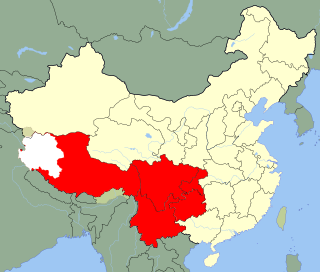Group armies or army groups or combined corps,are corps-level military formations of the People's Liberation Army Ground Force of China. Despite what the name suggests,current Group Armies are not army-level formations,but corps-sized formations commanding 12 to 14 brigades,roughly equivalent to United States Army Corps.

The Chengdu Military Region was one of seven military districts and is located in the southwest of the People's Republic of China,covering Chongqing,Sichuan,Yunnan,Guizhou,and the Xizang/Tibet Autonomous Region. It includes some of the area previously within the Kunming Military Region and has its headquarters in Chengdu. It was probably established in 1955.

The Guangzhou Military Region was from 1955 to 2016 one of the People's Liberation Army PLA Military Regions,located in the south of the People's Republic of China. In May 1949,the Central China Military Region (MR) was formed. In March 1955,it was divided into two,the Guangzhou MR and the Wuhan Military Region. When the Wuhan MR was disbanded in August 1985,its troops stationed around the Hubei province were assigned to the Guangzhou MR.

The Jinan Military Region was a PLA Military Region located in the east of the People's Republic of China,covering the Shandong and Henan Provinces,which also formed military districts. It appears that Yang Dezhi was one of the first commander of the Jinan MR,from 1958. It was considered a strategic reserve. It included some of the area previously within the Wuhan Military Region,which was disbanded in 1985–88.

The Shenyang Military Region was one of seven military regions for the Chinese People's Liberation Army. It has command and control of military and armed police forces in the three northeast provinces of Jilin,Heilongjiang,and Liaoning,which also form Military Districts. This region is now superseded by the Northern Theater Command.

The Nanjing Military Region was one of the former seven military command regions for the Chinese People's Liberation Army. Its jurisdiction covers all military and armed police located in Anhui,Jiangsu,Zhejiang,Jiangxi,Fujian,and Shanghai. It also covers Taiwan,which is claimed by the People's Republic of China but administered by the Republic of China. The head of the region was Cai Yingting. This region is now part of the Eastern Theater Command.

The Xinjiang Military District (新疆军区) is a special military area of the PLA at the Theater Deputy-grade.(副战区级). It is one of three districts that are directly under the Central Military Commission and its Joint Army Staff rather than under their Theater Command

The 72nd Group Army,Unit 31657,formerly the 1st Group Army,is a military formation of the Chinese People's Liberation Army Ground Forces (PLAGF). The 71st Group Army is one of thirteen total group armies of the PLAGF,the largest echelon of ground forces in the People's Republic of China,and one of three assigned to the nation's Eastern Theater Command. Headquartered in Huzhou,Zhejiang,the unit's primary mission is likely preparation for conflict in or about the Taiwan Strait.

The Central Theater Command is one of the five theater commands of the People's Liberation Army of China,and was founded on 1 February 2016. Its predecessors were the Beijing Military Region and Jinan Military Region.
The 4th Division was created in February 1949 under the Regulation of the Redesignations of All Organizations and Units of the Army,issued by Central Military Commission on November 1,1948,basing on the 4th Independent Brigade,2nd Column of the PLA Northwest Field Army. Its history can be traced to the 4th Independent Brigade of Lvliang Military District,formed in November 1945.
The 29th Division,now as the 56th Heavy Combined Arms Brigade is a military formation of the People's Liberation Army of the People's Republic of China. It is now one of six combined arms brigades of the PLA 76th Group Army. It is the unit that experienced the most times of unit transferring in the PLA Ground Force.
The 1st Division of Xinjiang Production and Construction Corps is a para-military formation of the Xinjiang Uygur Autonomous Region,China.
The 5th Army Division formed in December 1967 by Jinan Military Region. Soon after its formation,in May 1968,the division was transferred to Urumqi,Xinjiang.
2nd Cavalry Division(Chinese:骑兵第2师)(3rd formation) was formed in October 1962 from 4th and 5th Cavalry Regiment from 1st Cavalry Division,and 6th and 7th Independent Cavalry Regiment of Lanzhou Military Region.
The 193rd Division was created in February 1949 under the Regulation of the Redesignations of All Organizations and Units of the Army,issued by Central Military Commission on November 1,1948,basing on the 22nd Brigade,8th Column,2nd Army Group of Huabei Military Region. Its history could be traced to the famous 1st Division of Chinese Workers' and Peasants' Red Army.
The First Field Army of the Chinese Communist Party was a military formation in the last stages of the Chinese Civil War (1949–1950).
The 11th Division was created in February 1949 under the Regulation of the Redesignations of All Organizations and Units of the Army,issued by Central Military Commission on November 1,1948,basing on the 3rd Security Brigade,4th Column of the PLA Northwest Field Army. Its composition can be traced to 84th Division of 27th Corps,Military Division of Shaanxi-Gansu,29th Corps,Independent Division of Shanganning,2nd Regiment of Shanganning,1st Independent Division of Northern Shaanxi and Headquarters,4th Corps,all parts of Chinese Workers' and Peasants' Red Army.
The 1st Cavalry Division was a division of the People's Liberation Army. It was created in March 1949 under the Regulation of the Redesignations of All Organizations and Units of the Army,issued by Central Military Commission on November 1,1948,basing on Cavalry Brigade of Jinsui Military District. Its history can be traced to Cavalry Brigade of Shanganning-Jinsui Coalition Army formed in 1942.
The Chinese order of battle in the 2020–2021 China–India skirmishes.









